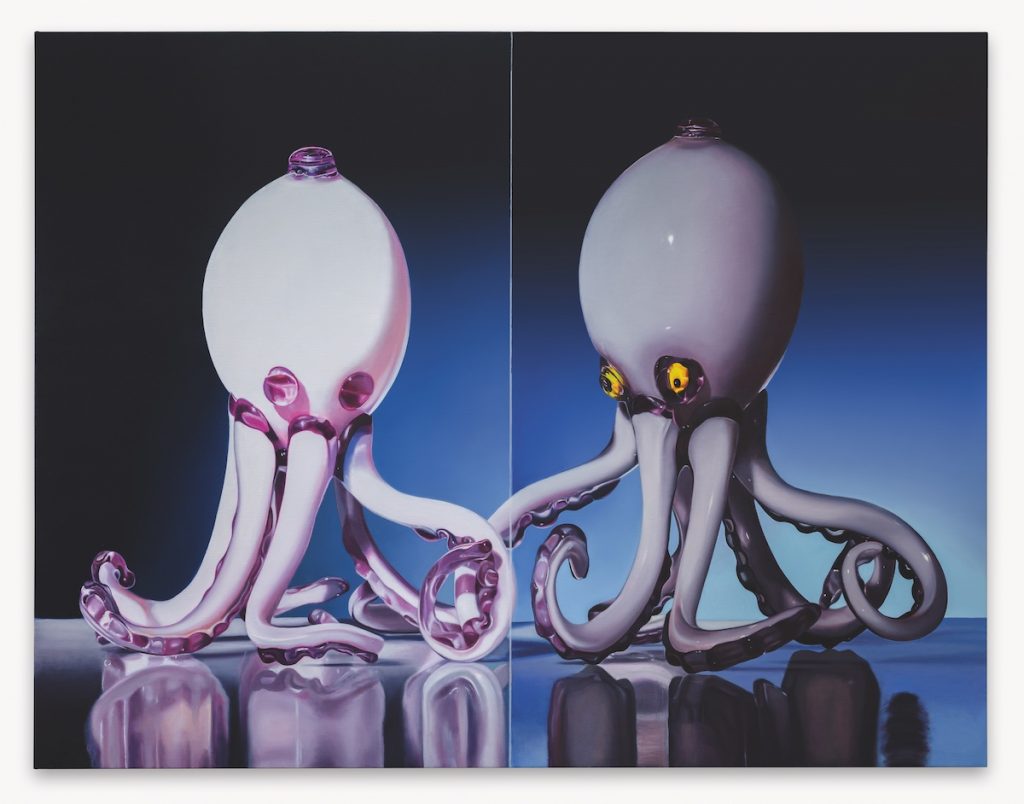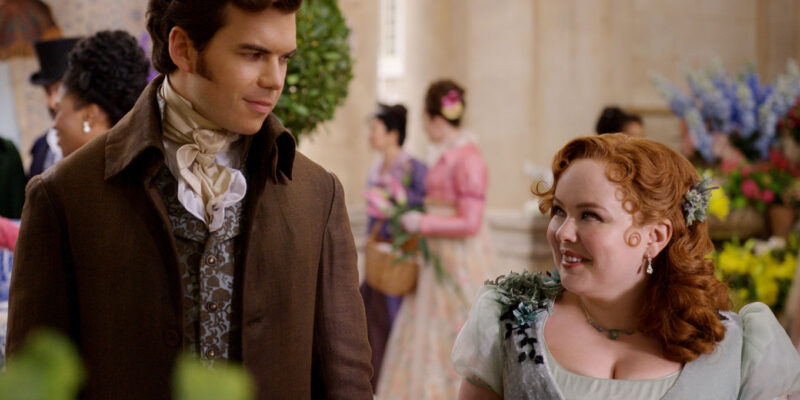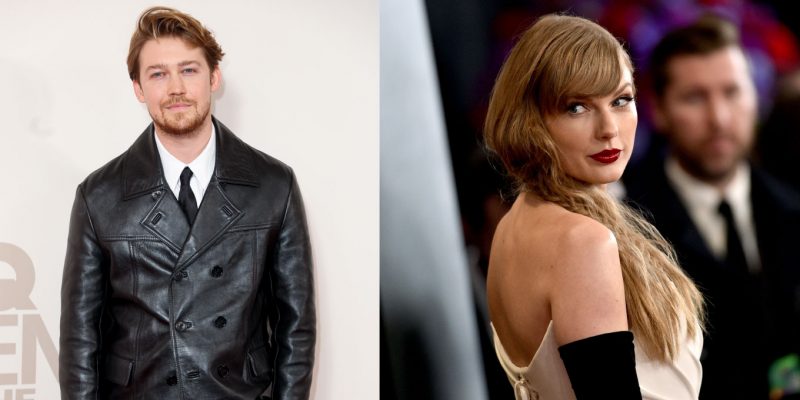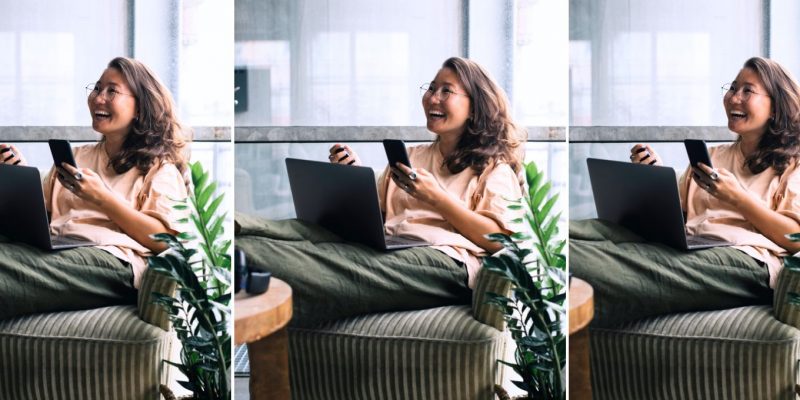Society
Canadian Painter Allison Katz's Complex Strokes
Katz is quietly making her mark on the international art world.
by : Joanna Fox- Mar 29th, 2023

Portrait of the artist as a young girl(S) (2022) by Allison Katz (Eva Herzog)
Allison Katz has always been drawn to the performative. Growing up, she wanted to be an actor, but because of a series of operations on her right arm that began when she was 11 and lasted into her late teens, she spent a lot of time convalescing on her own and was forced to channel her creative energy into a more protracted form of engagement: drawing and, eventually, painting. “I had to retreat into my inner life, which actually suited me quite well,” says Katz. “I didn’t feel so public-facing anymore, but it wasn’t through my own intentions, so I had to grapple with that and the [worry about the fact] that the arm that was fragile and scarred was also the one I used to make artwork, [which was what] connected me back to the world. So it all got mixed up, this sense of an alternative persona or a hidden performance in my painting, which I then carried with me into my work… I don’t know. There’s a misty origin story in there somewhere.”
These days, there’s no doubt that the Montreal-born artist, who’s now based in London, England, is crystal clear about her career. Last year alone, Katz was part of a curated group show, The Milk of Dreams, at the Venice Biennale; one of her paintings, Portrait of the Artist as a Young Girl(s), was acquired by London’s Tate Modern gallery; and it was announced that Hauser & Wirth—arguably the world’s top gallery, with locations in the U.S., the U.K., Switzerland, Spain, Monaco and Hong Kong—is now representing her. This new partnership joins her pre-existing relationships with galleries in Shanghai (Antenna Space), Milan (Gió Marconi) and Brussels (Dépendance).
The 42-year-old has had solo exhibitions at the MIT List Visual Arts Center in Massachusetts, Ontario’s Oakville Galleries, the U.K.’s Nottingham Contemporary and London’s Camden Art Centre. Artery, the show presented at the latter two galleries, inspired a book, Allison Katz: Artery, which will be released on April 11 and, according to Katz, “situates itself somewhere between a monograph, an exhibition catalogue and an artist’s book.” Right now, she is preparing for her first solo exhibition with Hauser & Wirth at its West Hollywood, L.A., gallery space, slated for later on this year.
But Katz’s career didn’t blow up overnight. She has been hard at work for the past two decades, quietly making her mark as part of a new generation of painters who are elevating the art form in interesting ways—and turning heads along the way.
 Dry Goods (2022) by Allison Katz
Dry Goods (2022) by Allison Katz In the late 1990s, when Katz was a teenager growing up in Montreal, she took a month-long summer painting class in New York City and stayed in a dorm for the duration. “It was so overwhelming,” says Katz of the coming-of-age trip. “It was an assault [on all my senses], but it also set this connection between risk and painting [and between] the city and some sort of discomfort zone. There was this conventional structure—we were going to class every day to oil-paint—but most kids were not taking that seriously, [whereas] I was extremely gripped by the painting part and less so by the partying part. It was such an intense but liberating month. That was maybe [my] first encounter with the things [that] painting can do.”
While completing her bachelor’s degree in fine arts at Concordia University in the early aughts, Katz would model for a mentor of hers, artist Susannah Phillips. “She comes from a lineage of artists, and she taught me so much about how to see and what to look at, and I felt really blessed that I had this whole other education alongside school,” says Katz. “I understood early on that [an art practice is] self-directed—you’ve got to find mentors and you’ve got to find models. And in posing for someone else’s painting, I found myself on both sides of the canvas. I thought that was a really strange role as a woman: You are being looked at, but [this gaze] is also something that you are trying to question as an artist. At the same time, the gaze on me was another woman’s, so it felt like I was engaging in something outside of the historical norm.”
Katz’s painting style makes the viewer think—things are not quite what they seem. Her diverse imagery includes cocks (the bird) and cabbages, open toothy mouths, fairies, elevators, noses and waterways, and she creates layers and depth in her pieces, both literally and metaphorically. “Painting can be a heavy medium—mentally, traditionally and culturally speaking,” she says. “So [finding] a way to lighten it and see [other] sides of it, [which means] sometimes using both sides of the wall in an exhibition set-up, is very generative [for me]. It reminds me of being both the painting and the painter and [having] that freedom to look behind something.”
Milk Glass (2022) by Allison Katz
 Milk Glass (2022) by Allison Katz (Eva Herzog)
Milk Glass (2022) by Allison Katz (Eva Herzog) How the viewer sees Katz’s pieces—how she presents them in a particular space—is part of her carefully-thought-out process. To her, the initial encounter with a piece is crucial . “How you first see it or what you see it [in context] with is the kind of thing I can play with and control temporarily,” she says. “To me, the exhibition is essential to finishing the painting—and almost to making the next painting. The way you turn a page in a magazine, that idea of rhythm and sequence—I believe [that’s] happening in a space. What you see first and what sorts of views in a room you chance upon have been very carefully thought about.”
With her work, Katz is trying to change how we think about painting as a medium as well. She explains that in other art mediums, we accept a certain amount of education or literature around whatever piece we’re looking at, yet with painting, there’s a current resistance to going beyond what’s in plain sight on the canvas. “Previously, painting was always dependent on interpretation, so [with my work], I feel like I have this relationship with some of the things that painting does so well, like coding, disguising, camouflaging, the slow reveal—[creating an] image [that isn’t] what it appears to be,” says Katz. “There’s this idea that with painting, [interpretation is] not what you do anymore, but I believe [the opposite].”
For now, she’s taking everything in her stride, including her new representation and her first show with the gallery. “Hauser & Wirth offers a way of looking at and thinking about art that is very nurturing to an artist of my generation,” says Katz of the gallery, which also represents some of the world’s top contemporary artists, including George Condo, Cindy Sherman and Rita Ackermann. “I joined the gallery because so many of the artists I admire are in its roster. The support, belief and vision [it offers are] unparalleled.”
Despite the pressure of this competitive world and the creativity and energy involved in her medium, Katz seems more focused and productive than ever. She just wrapped up a three-month residency at Hauser & Wirth’s Somerset, U.K., gallery, working in its barn studio and living in a small adjacent cottage. “It [was] a great way to spend the start of the year: in solitude, reflection and new surroundings as I prepared my next body of work,” she says. Considering that Katz is at the forefront of contemporary painting, it will definitely be worth the wait.
Read more:
7 Must-Know Artists Shaping The Canadian Arts Scene
For Artist Chloe Wise, It All Comes Naturally
Artist Yumi Nu Lives in the Now
Newsletter
Join our mailing list for the latest and biggest in fashion trends, beauty, culture and celebrity.
Read Next

Fashion
Tennis Champions Roger Federer and Rafael Nadal Climb a Mountain With Louis Vuitton
An Odyssey of rivals turned friends.
by : Allie Turner- May 18th, 2024

Culture
Two ‘Bridgerton’ Cast Members Are Dating IRL
The Ton is a-twitter with rumours.
by : Rebecca Mitchell- May 17th, 2024

Life and Love
Have You Tried These Goodies for Sexual Wellness Yet?
Consider this your sign that it’s time to improve your sexual well-being—a key part of your overall health.
by : ELLE Canada- May 7th, 2024




